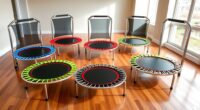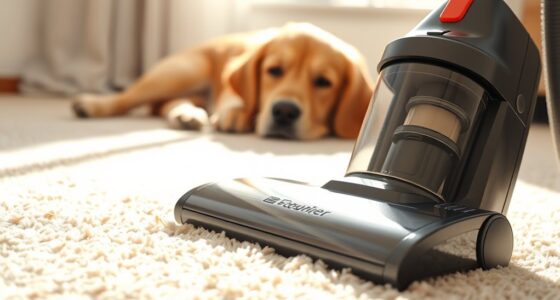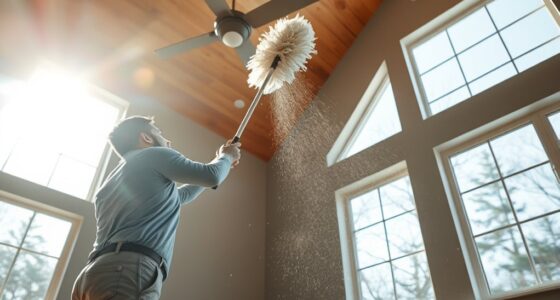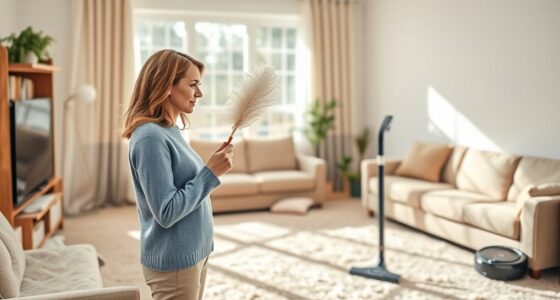If you have allergies, vacuum your home at least twice a week to reduce dust mites, pet dander, and other allergens. Regular cleaning helps keep allergens from building up and improves your indoor air quality, which can lessen allergy symptoms. Be sure to use a vacuum with a HEPA filter and focus on high-traffic areas and under furniture. Continuing this routine can create a cleaner, healthier living space—more tips to optimize your efforts follow.
Key Takeaways
- Vacuum allergy sufferers once or twice weekly to reduce dust mites and allergens effectively.
- Increased frequency prevents allergen buildup in humid environments.
- Regular vacuuming supports better indoor air quality and symptom relief.
- Use a vacuum with HEPA filters and proper tools for thorough allergen removal.
- Consistent vacuuming maintains carpet condition and promotes a healthier living space year-round.

Have you ever wondered how often you should vacuum to keep your home clean and healthy? If you or someone in your household suffers from allergies, the answer is especially important. Regular vacuuming isn’t just about keeping floors looking tidy; it plays an essential role in carpet maintenance and dust mite control. Carpets tend to trap dust, pet dander, and other allergens that can aggravate allergies or asthma. By establishing a consistent vacuuming routine, you can considerably reduce these irritants and improve indoor air quality.
Regular vacuuming reduces allergens and improves indoor air quality, especially for allergy sufferers.
For allergy sufferers, vacuuming once or twice a week is generally recommended. This frequency helps prevent the build-up of dust mites and allergens deep within your carpet fibers. Dust mites thrive in humid environments, and carpets provide an ideal habitat for them to multiply. Regular vacuuming removes their food sources, such as dead skin cells, and disrupts their habitat, reducing their presence in your home. Using a vacuum with a HEPA filter enhances dust mite control by trapping tiny particles that traditional filters might miss, ensuring cleaner air and a healthier environment.
Carpet maintenance goes beyond just vacuuming frequently. It’s important to choose the right tools and techniques. Opt for a vacuum with strong suction and adjustable settings to effectively clean different carpet types. Make sure to go over high-traffic areas multiple times, especially along edges and under furniture, where dust and debris tend to settle. Regularly replacing or emptying your vacuum bag or canister prevents loss of suction, ensuring each pass removes as much dirt and allergens as possible. Additionally, consider frequent deep cleaning or professional carpet treatments for a more thorough removal of embedded allergens and to prolong your carpet’s lifespan.
Consistent vacuuming not only keeps your carpets looking fresh but also plays an essential role in maintaining a healthy indoor environment. It minimizes the presence of dust mites, pet dander, and other common allergens that can trigger allergies or respiratory issues. For households with allergy sufferers, establishing a routine of weekly vacuuming can make a noticeable difference in symptom relief and overall air quality. Incorporating robotic vacuum cleaners can further enhance your cleaning routine by maintaining consistent floor cleanliness with minimal effort. Remember, the key is regularity and using the right equipment—this guarantees your carpets stay in good condition and your home remains a safe haven from allergens. So, make vacuuming a priority, and enjoy a cleaner, healthier living space all year round.
Frequently Asked Questions
Can Vacuuming Help Reduce Pet Dander Effectively?
Vacuuming can effectively reduce pet dander by removing airborne allergens and dirt trapped in carpets. Using a vacuum with good carpet filtration captures more allergens, preventing them from becoming airborne again. Regular vacuuming, at least once a week, helps keep pet dander levels low, especially in carpets and upholstery. This minimizes allergic reactions, making your home more comfortable for allergy sufferers and improving overall indoor air quality.
What Vacuum Cleaner Features Are Best for Allergy Sufferers?
Think of your vacuum as a shield against allergens. Look for models with HEPA filters that are air filter compatible, trapping tiny particles before they escape. An ergonomic design makes cleaning less of a chore, letting you move easily and reach tricky spots. These features work together like a fortress, clearing pet dander and dust, so your home feels fresher, and your allergies stay at bay.
Should I Vacuum More Often During Certain Seasons?
Yes, you should vacuum more often during seasons with higher seasonal pollen and mold spores. Pollen levels peak in spring and summer, while mold spores increase in damp fall and winter. Increasing your vacuuming frequency helps remove these allergens from your home surfaces and carpets, reducing allergy symptoms. Consider vacuuming at least twice a week during these seasons to keep allergens at bay and maintain a healthier indoor environment.
How Do I Prevent Allergen Buildup in Upholstery?
Oh, sure, just sprinkle fairy dust on your upholstery to keep allergens at bay. In reality, you should focus on dust mite control and fabric protection by vacuuming regularly with a HEPA filter, washing cushions, and using slipcovers. This prevents allergen buildup and creates a healthier space. Don’t forget, consistent effort beats wishful thinking—so vacuum often, and keep allergens from sneaking into your fabric sanctuary.
Is It Better to Vacuum in the Morning or Evening?
You should vacuum in the morning for better timing considerations and energy efficiency. Morning vacuuming helps remove allergens before they settle further into carpets and upholstery, improving indoor air quality. Plus, you’ll use less energy, since your home is likely cooler and more ventilated. Vacuuming in the evening can work too, but morning sessions give you the advantage of fresh, allergen-free surfaces to start your day.
Conclusion
Regular weekly vacuuming can considerably reduce allergens in your home. For example, imagine Sarah, who struggled with allergy symptoms until she committed to vacuuming every week. After just a month, she noticed her sneezing and congestion lessened. Consistency is key—by sticking to a weekly routine, you create a cleaner, healthier environment. So, make vacuuming part of your weekly schedule, and enjoy breathing easier in your allergy-friendly space.









